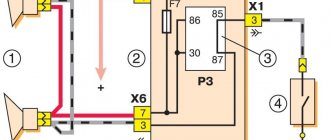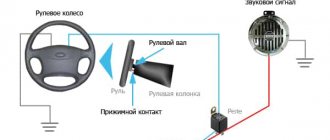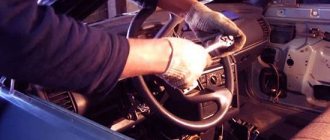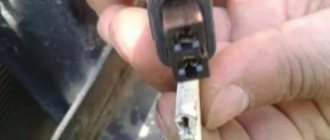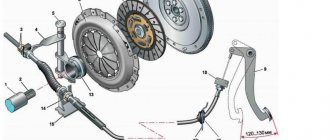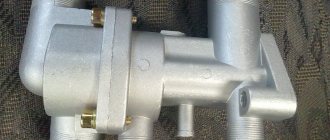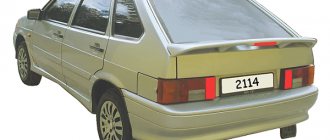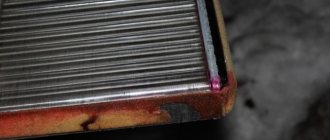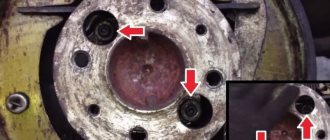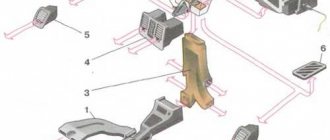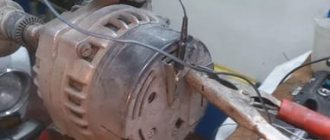04/27/2021 16,640 VAZ 2110
Author: Ivan Baranov
Every car must have a working horn. Thanks to the horn, the driver can prevent an emergency situation on the road and avoid a possible collision. But it often happens that the horn refuses to work. For what reasons does the sound signal on the VAZ 2110 not work and how to fix this problem - read below.
[Hide]
Probable Causes
Based on the nature of the signal malfunction in the VAZ-2110, it can be divided into two groups.
In the first case, the horn does not operate at all, no matter how the driver presses the button located in the center of the steering wheel.
The second option is that the sound is intermittent, that is, the signal begins to work unstable.
Among the most obvious and easily remediable causes, the main one is a blown fuse. A break in the fuse link de-energizes the entire electrical circuit, and, accordingly, the horn does not function at all. To check, just turn on the heater fan. It is connected to the same protective device.
Also, the horn itself often breaks on the 2110 model. This version is accepted as the main one if installing a working fuse does not lead to a positive result. Here you will have to tinker longer:
- the signal is removed (it is located behind the radiator grille);
- connect directly to a battery or other 12-volt power source (the white wire is “plus” and the black wire is “minus”);
- If the device itself is faulty, then it will not produce a characteristic sound.
When everything is in order with the node, then you should suspect a break that occurred somewhere in the circuit.
The next possibility is abrasion of the clamping contacts installed directly in the steering column. This is more likely the older the “ten” is. By the way, it is not difficult to extend their service life - it is enough to regularly treat the contacts with graphite-based lubricant.
Also, sometimes the problem lies in the oxidized terminals of the pads. Inspect the one located in the steering column, and the second one in the engine compartment. At the same time, make sure that all wiring is securely fastened.
VAZ sound signal does not work
A non-functioning horn on a car is a very dangerous malfunction. The most unpleasant thing is that they find out about this breakdown just when the signal is needed most - in a dangerous situation on the road. What could cause the signal to fail?
There are several reasons why the horn may stop working. Almost all of them are electrical and simply involve no contact where it should be. Let's go through them all:
Horn fuse blown
The very first and easiest check that can be performed when the sound signal is not working is the integrity of the fuse. If it turns out to be burnt out, then there may be a short circuit in the car.
We recommend: Audi 80 b3 fuses: where they are, replacement
Try inserting a whole fuse that matches the rating (How to choose a fuse. Colors and ratings). If it burns out in the same way, it means there is actually a short circuit.
If not, then perhaps the fuse has simply exhausted its resource and you should pay attention to other reasons.
The horn button does not work
The signal in most cars is turned on by a button in the center of the steering wheel. There are variations with a button in the steering column switch or a certain position of this switch itself, but this is rare.
There are actually a whole bunch of places inside the steering wheel where contact can be lost, leading to the failure of the horn. To understand exactly where they can be located, you need to understand how the sound signal in the car turns on. Let's look at the diagram.
Diagram for connecting an audio signal via a relay
This circuit assumes the presence of a signal activation relay. This relay is found on all modern cars. On a certain category of cars (for example, VAZ classics), there is no relay. In this case, the signal is connected directly through the button on the steering wheel.
The diagram shows that there are two electrical circuits: control and power. The power circuit feeds the signal and does not come into the car interior; the control circuit, on the contrary, comes to the steering wheel.
When you press the signal button, the control contacts of the relay close, connect the power circuit and the signal turns on.
What are relays, control and power contacts, read the article: how a relay works in a car.
The control current from the relay is transmitted from the steering column to the steering wheel through a floating contact. There may be one, or maybe two. These contacts rub against a special conductive ring built into the steering wheel at the point where it is attached to the steering shaft. Due to the fact that the contacts are spring-loaded, they are constantly pressed against the ring, ensuring the transmission of current to the steering wheel in any position.
How to choose
Having decided to replace a relay or fuse in a Priora, take full responsibility for their selection and purchase. Under no circumstances should you buy cheap parts of unknown quality and origin.
It is better to give preference to original products produced by VAZ. As a last resort, buy relays or fuses from one of the well-known companies, such as Bosh, Hella or Tesla.
Replacing the sound signal on a Lada Vesta is a simple procedure that any owner should be able to perform. After all, driving without a properly working horn is a priori unsafe, and taking a car to a service station due to such a breakdown is an unreasonably large amount of time. However, replacement in the event of a malfunction is not the only need. Many people are simply not satisfied with the volume or tone of the sound signal, and they replace the standard Vesta components with alternative ones. Therefore, both of these paths need to be considered in more detail.
The feasibility of self-repair
So does it make sense to repair the horn yourself? If we take into account the recommendations described above, then the repair is advisable only if the car owner is as careful as possible when performing it. After all, during the repair work, there is a high probability that an inexperienced car enthusiast will damage the wiring in the unit or connect the contacts incorrectly. Therefore, if you have never encountered a repair procedure before, it is better to entrust this matter to specialists or simply replace the horn assembly.
Methods for troubleshooting
If the horn circuit is broken and the horn stops working, then there are several options for solving the problem:
- First you need to diagnose the safety device. If this part is burnt out, then you just need to replace it with a new one; the device is located in the mounting block. The replacement process will not take much time; any car enthusiast can cope with this task. If replacing the fuse gave results, but after some time the horn stopped working again, then most likely the reason lies in voltage surges in the on-board network. Overload contributes to accelerated burnout of the fuse element, so you will have to look for the source of the load and solve the problem. To do this, use a multimeter or seek help from an electrician.
- If the horn itself malfunctions, the device must be replaced. If diagnostics by direct connection to the battery do not produce results, then most likely the reason lies in the device itself, which needs to be changed.
- Short circuit. To diagnose, you will need a multimeter and a little experience. Using a tester, you can find a short circuit, but if you have never encountered such a problem before, it is better to seek help from specialists.
- If the clamping contacts or slip ring are worn out, then the failed elements must be replaced. It is not a fact that you will be able to buy new contacts or a ring, so most likely you will have to change the horn assembly.
- Another reason why the horn does not work is oxidation of the internal contacts. Over time, as mentioned above, dirt and deposits accumulate on them, which leads to the obstruction of sound. You can try to disassemble the steering wheel of the car, then clean the internal contacts and assemble the steering wheel (the author of the video is the channel Alexander Amochkin Kolomna AAK).
If you are faced with the problem of a non-working horn, then you will probably be wondering how to replace it:
First of all, you need to remove the steering wheel. To do this, remove the trim and unscrew the bolts that secure the steering wheel.
After the steering wheel is removed, you can clean the contact tracks, perhaps this will help solve the problem
Make sure that the wire contacts in the column are as clean as possible.
Unscrew the two screws located under the plastic cover. After dismantling the cover, you will be able to see the contact plate; there is a possibility that the problem lies there.
Clean the contacts and check the signal functionality. If the horn does not work, then using a 24mm wrench you will need to unscrew the nut, but you do not need to unscrew it all the way.
Next, the steering wheel itself must be pulled towards you; this will require some effort. You can try to move the wheel by tapping it from different sides. When you feel that the steering wheel has given way, the nut is unscrewed completely.
After dismantling the steering wheel, we proceed to removing the horn. There is a module located under the grille of the radiator unit; it must be removed; to do this, unscrew the nut to 13 and disconnect the connector.
Install a new one, replace the steering wheel and check the operation of the horn.
VAZ horn repair
The absence of a sound signal on a car is a malfunction that affects traffic safety. The ability to promptly warn or attract the attention of pedestrians, as well as other road users, directly with the horn, can help avoid creating an emergency situation or an accident.
We recommend: How to properly change the cabin filter on a Daewoo Nexia?
A malfunction such as the absence of a sound signal on VAZ family cars is quite easy to diagnose and repair with your own hands. To do this, you need to study the connection diagram (it is very simple) and follow the instructions to carry out the necessary checks.
VAZ sound signal diagram
Although the connection diagrams are slightly different on “classics” and front-wheel drive VAZ cars, they are very similar. The only difference is in the relay markings and the location of the fuse, otherwise they are completely identical.
Wiring diagram for the sound signal VAZ 2101, 2102, 2103, (2106 after 1993), without relay:
- Sound signals S-308 and S-309, (2106 - 20.3721-01);
- Battery;
- Fuse box (1 per signal);
- Horn switch (steering wheel button);
- DC generator;
Sound signal circuit for VAZ 2104, 2105, 2106, 2107, 2121, with relay:
Where:
- Sound signals S-309 and S-308;
- Battery;
- Generator;
- Fuse box;
- Horn button on the steering wheel;
- Horn relay RS – 528;
Diagram of sound signals VAZ 2108, 2109, 21099, 2113, 2114, 2115:
Where:
- Sound signal;
- Fuse and relay mounting block;
- Steering wheel button;
Diagram for switching on the sound signal of VAZ 2110, 2111, 2112 and their modifications:
- Sound horn;
- Power button on the steering wheel;
- Mounting block with fuse (no relay)
Diagram for turning on the sound signal on VAZ 1117, 1118, 1119, 2192, 2194 (Kalina), VAZ 2170, 2171, 2172 (Priora):
- Fuse and relay mounting block (control and comfort unit);
- Horn button on the steering wheel;
- Sound signal;
Replacement and repair of VAZ sound signal
The most common reason for the absence of a sound signal lies in the signals themselves. The reason is mechanical, moisture and oxidation lead to blocking of the sound membrane and, as a result, the absence of vibrations and sound effect. Sometimes you can restore functionality by spraying the signal with WD-40 or a similar composition.
Video:
On cars, where two signals are installed, as a rule, they are of different tones, low and high. If one signal fails, the second will not be able to fully provide the required power, and therefore requires replacement.
As a rule, many signals are equipped with a tone adjustment screw, and if there are wheezing, grinding and other unwanted sound effects, you can use the adjustment to achieve a suitable sound.
Also, with their help, you can move the “soured” membrane, thereby restoring the functionality of the signal.
Is a Volga horn good?
Is it possible to use a signal from the Volga in the “ten”, how to install it and how to connect it yourself? In the VAZ 2110 it is allowed to install a Volga horn, and the latter can be either old or new model. There is no particular difference between these details, except that the tonality will be slightly different. And, of course, the cost. But keep in mind that installation by simply replacing the device will not work.
The bottom line is that two cables are connected to the standard device - one with a negative output, which comes from the button on the steering wheel, and the other with a positive one. The latter is permanently connected; it also powers the ventilation device of the radiator unit. But in Volga devices, only one cable is used - positive, since the mass in this case is supplied through the body, that is, from the attachment to the vehicle body. In addition, you must also take into account that both systems use different current consumers - the standard options require no more than 5 amperes, while the Volga ones require 8 amperes each. The result is 16 amperes (video author - Master Bruce).
Accordingly, to correctly connect a product from Volga to a VAZ 2110, you will need a four-pin relay; you have several options for installing it:
- in the vehicle interior, in the mounting block with fuses;
- in the engine compartment, but in this case, please note that the relay should be securely insulated to prevent moisture from entering.
